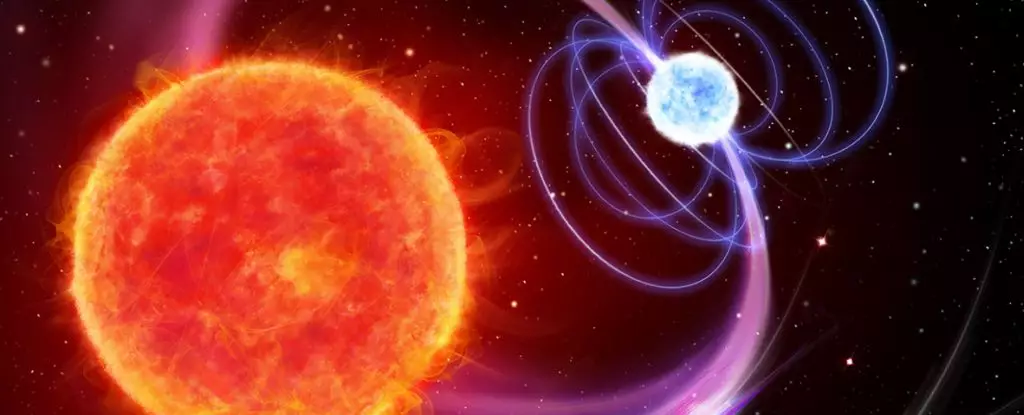The cosmos has always held secrets, many of which have taken years, if not decades, to unravel. Recently, astronomers have made a groundbreaking discovery that shines light on one such mystery. A curious source of radio signals, now identified as ILT J110160.52+552119.62, has emerged from a binary star system located approximately 1,645 light-years away from Earth. The revelations made by a team led by Iris de Ruiter at the University of Sydney have not only defined the origins of these signals but have also rewritten a chapter in our understanding of celestial mechanics and radio astronomy.
The peculiar phenomenon manifests as radio waves pulsing with a consistency that is uncommon in the field—occurring every 125.5 minutes. These signals are reminiscent of fast radio bursts (FRBs), which typically emerge from more distant and energetic sources. However, the distinctive traits of ILT J1101+5521 highlight an entirely new category of radio emissions, suggesting a sophisticated interaction between two stars—one a red dwarf and the other a much smaller white dwarf.
Two Stars in a Harmonious Dance
The discovery of ILT J1101+5521 cataloged a stellar pairing that spins around each other in tight orbits. The white dwarf—the remnants of a once-mighty star—exudes residual heat while the cooler red dwarf contrasts in brightness. In this intricate ballet, the proximity of these stars leads to a cataclysmic interaction between their magnetic fields, resulting in the periodic burst of radio waves detected by our instruments.
What sets this discovery apart is that it challenges the assumptions held about the origins of various radio emissions. As noted by Charles Kilpatrick, an astrophysicist from Northwestern University, understanding that some long-period radio transients derive from binary systems opens new avenues for research. This could radically transform our approach to classifying celestial signals and investigating their sources.
Unraveling the Signals: A Methodical Investigation
De Ruiter’s investigative journey began when she first stumbled upon the mysterious radio signals in data collected by the LOFAR radio telescope array. After careful analysis, her team traced the signals back to as early as 2015. Unlike their fast radio burst counterparts, which are explosive and fleeting—lasting mere milliseconds—ILT J1101+5521 emits prolonged pulses that average about a minute in duration. This marked distinction in timing and energy levels provided critical clues suggesting an entirely different mechanism fueling these emissions.
Challenging the previous assumptions surrounding short-lived FRBs, the ILT J1101+5521 signals encouraged a fresh perspective on the possible interactions between celestial entities. The collaborative effort involving multiple observatories, including the Multiple Mirror Telescope in Arizona and the McDonald Observatory in Texas, underscored the importance of cross-disciplinary cooperation in astronomy. The team’s findings leaned toward a broader understanding of the astrophysical phenomena at play in binary star systems.
Implications for Astrophysics
The implications of this discovery extend beyond merely understanding ILT J1101+5521. It raises questions regarding the characteristics of other celestial bodies and the nature of their interactions. Given the diverse types of variable stars and the ever-expanding catalog of radio pulses detected across the galaxy, this finding suggests that previously unexplored relationships and configurations between stars may yield similar emissions.
The insights gained from studying ILT J1101+5521 could illuminate the properties of magnetars, which are known for their intense magnetic fields and periodic radio emissions. By connecting these dots, researchers may finally piece together the entire puzzle surrounding the origins of some of the more mysterious radio signals that have been detected throughout the universe.
A Future of Discovery
As the team moves forward with their research into ILT J1101+5521, the astronomical community buzzes with excitement. This discovery opens numerous doors to exploring binary systems and calls for a deeper examination of the intricate celestial mechanics involved. Each study brings with it the potential to redefine the frameworks within which we operate, enriching our understanding of the universe and its workings.
In a time where humanity yearns for knowledge about our cosmic neighborhood, findings such as those about ILT J1101+5521 remind us: the universe is far more intricate and interconnected than it often appears. The ongoing exploration of these stellar interactions is not merely a scientific endeavor; it is an invitation to venture further into the unknown, to embrace the mysteries that lie beyond our world and to unlock the secrets that the cosmos holds within its vast expanse.

